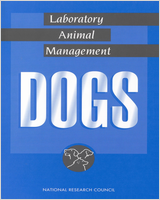NCBI Bookshelf. A service of the National Library of Medicine, National Institutes of Health.
This newly revised edition incorporates the regulatory requirements and improved practices for laboratory animal care that have developed over the past two decades.
The volume covers
- Selection of dogs as research models.
- Design, construction, and maintenance of facilities.
- Temperature, humidity, food, water, bedding, sanitation, animal identification, record keeping, and transportation.
- General veterinary care, as well as special care of breeding animals and random-source animals.
Laboratory Animal Management:Dogs discusses how to assemble a proper research protocol and how to handle conflicts. Outlined are procedures for institutional animal care and use and committee review. The volume also presents guidelines for handling aging dogs, use of radiation in experiments, and a wide range of other special circumstances.
Thoroughly referenced, this guide will be indispensable to researchers, research administrators, review committees, and others concerned about laboratory dogs.
Contents
- COMMITTEE ON DOGS
- CONTRIBUTORS
- INSTITUTE OF LABORATORY ANIMAL RESOURCES COUNCIL
- COMMISSION ON LIFE SCIENCES
- The National Academies
- Preface
- 1. Introduction
- 2. Criteria for Selecting Experimental Animals
- 3. Husbandry
- 4. Management of Breeding Colonies
- 5. Veterinary Care
- 6. Special Considerations
- Appendix. Cross Reference
NOTICE: The project that is the subject of this report was approved by the Governing Board of the National Research Council, whose members are drawn from the councils of the National Academy of Sciences, National Academy of Engineering, and Institute of Medicine. The members of the committee responsible for the report were chosen for their special competencies and with regard for appropriate balance.
This report has been reviewed by a group other than the authors according to procedures approved by a Report Review Committee consisting of members of the National Academy of Sciences, National Academy of Engineering, and Institute of Medicine.
Any opinions, findings, and conclusions or recommendations expressed in this publication are those of the committee and do not necessarily reflect the views of DHHS, USDA, or other sponsors, nor does the mention of trade names, commercial products, or organizations imply endorsement by the U.S. government or other sponsor.
- NLM CatalogRelated NLM Catalog Entries
- Review Guide for the Care and Use of Laboratory Animals[ 1996]Review Guide for the Care and Use of Laboratory AnimalsNational Research Council (US) Institute for Laboratory Animal Research. 1996
- Review Behavioral Management Programs to Promote Laboratory Animal Welfare.[Management of Animal Care and ...]Review Behavioral Management Programs to Promote Laboratory Animal Welfare.Bloomsmith MA, Perlman JE, Hutchinson E, Sharpless M. Management of Animal Care and Use Programs in Research, Education, and Testing. 2018
- Review Culture of Care: Organizational Responsibilities.[Management of Animal Care and ...]Review Culture of Care: Organizational Responsibilities.Brown MJ, Symonowicz C, Medina LV, Bratcher NA, Buckmaster CA, Klein H, Anderson LC. Management of Animal Care and Use Programs in Research, Education, and Testing. 2018
- Laboratory Guidelines for Animal Care.[Methods Mol Biol. 2019]Laboratory Guidelines for Animal Care.Couto M, Cates C. Methods Mol Biol. 2019; 1920:407-430.
- Selection, acclimation, training, and preparation of dogs for the research setting.[ILAR J. 2006]Selection, acclimation, training, and preparation of dogs for the research setting.Meunier LD. ILAR J. 2006; 47(4):326-47.
- Laboratory Animal ManagementLaboratory Animal Management
Your browsing activity is empty.
Activity recording is turned off.
See more...
